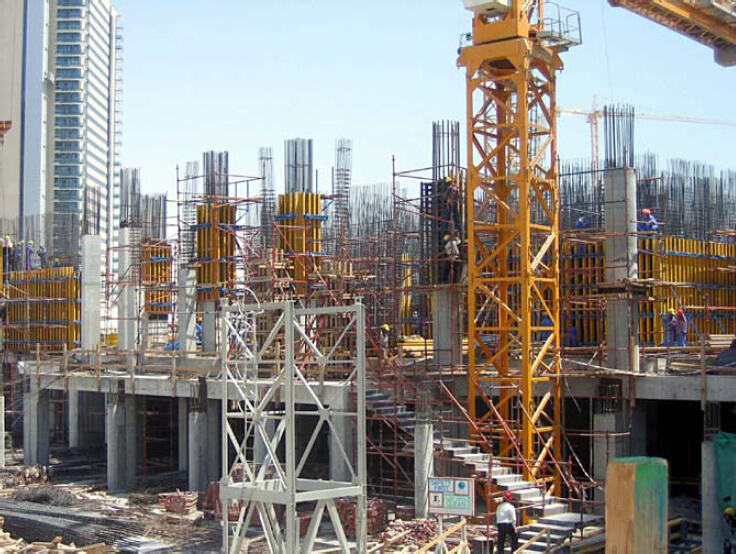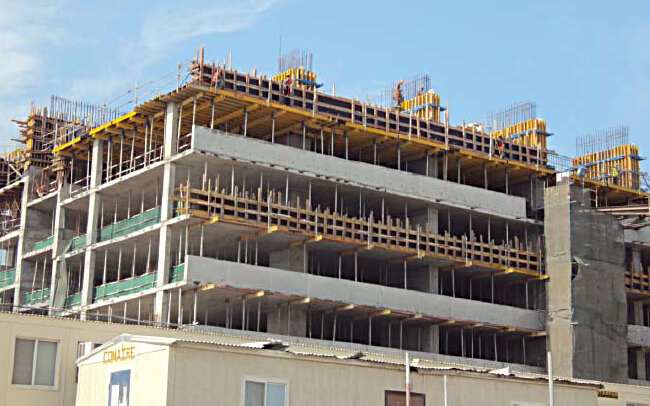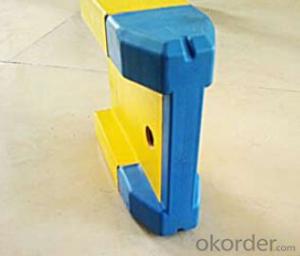Timber-Beam Formwork for Building Construction
- Loading Port:
- Tianjin
- Payment Terms:
- TT OR LC
- Min Order Qty:
- 50 m²
- Supply Capability:
- 1000 m²/month
OKorder Service Pledge
Quality Product, Order Online Tracking, Timely Delivery
OKorder Financial Service
Credit Rating, Credit Services, Credit Purchasing
You Might Also Like
Characteristics:
◆ Standardized production lines.
Supply capability: 3000m/day, Lmax = 6600mm.
◆ Finger jointing of the flange and web, the strength of timber beam is highly improved.
Max. shearing force failure load:40KN
◆ Well treated to prevent from water penetration or erosion, so the service life maximally
extended.
Normally, CNBM timber beam H20 can be used for 4 to 5 years, the exact using time would
depend on maintenance & storage.
◆ Robust caps at the end of the girders protect against damages.


- Q:Steel formwork in the construction project, after the completion of concrete pouring, the wall surface from the powder seriously how to deal with?
- There is a problem with the ratio of the concrete itself.
- Q:Can steel formwork be used for high-rise construction projects?
- Yes, steel formwork can be used for high-rise construction projects. Steel formwork is known for its strength and durability, making it suitable for heavy-duty applications such as high-rise construction. It provides excellent stability and support to the concrete during the pouring and curing process, ensuring the structural integrity of the building. Additionally, steel formwork can be easily assembled and disassembled, making it efficient for use in tall structures where multiple floors need to be constructed. Its reusable nature also allows for cost savings in the long run. Overall, steel formwork is a reliable and popular choice for high-rise construction projects.
- Q:What are the typical lead times for manufacturing and delivering steel formwork?
- The typical lead times for manufacturing and delivering steel formwork can vary depending on factors such as the complexity of the design, quantity required, and the current workload of the manufacturer. However, on average, it usually takes around 4-6 weeks for the manufacturing process, while the delivery time can range from a few days to a couple of weeks depending on the location and transportation arrangements.
- Q:What are the weight limits for steel formwork panels?
- The weight limits for steel formwork panels can vary depending on their size, thickness, and design. It is best to refer to the manufacturer's specifications or guidelines for the specific weight limits of the steel formwork panels being used.
- Q:Can steel formwork be used for curved or irregularly shaped structures?
- Curved or irregularly shaped structures can definitely utilize steel formwork. Unlike traditional wood formwork, steel formwork offers greater flexibility and can effortlessly conform to any desired curve or irregular shape. This renders it a perfect option for constructing structures with distinctive architectural designs or intricate geometries. Furthermore, steel formwork boasts exceptional strength and durability, guaranteeing its ability to endure the pressures exerted during the concrete pouring process and retain its shape throughout the construction phase. All in all, steel formwork presents a versatile and dependable solution for shaping curved or irregularly shaped structures.
- Q:How does steel formwork prevent concrete spalling?
- Steel formwork prevents concrete spalling by providing a strong and durable mold for the concrete to be poured into. The steel formwork holds the concrete in place during the curing process, preventing any movement or displacement that could lead to spalling. Additionally, the smooth surface of the steel formwork helps to create a uniform and even finish on the concrete, minimizing the risk of spalling.
- Q:What are the typical load capacities of steel formwork systems?
- The typical load capacities of steel formwork systems can vary depending on the specific type and design of the system. However, in general, steel formwork systems are known for their high load-bearing capabilities. For horizontal formwork systems such as slab formwork, the load capacities can range from 60 to 100 kN/m2 or even higher, depending on the thickness of the slab and the spacing of the supports. This allows for the efficient construction of reinforced concrete slabs and beams that can withstand heavy loads. Vertical formwork systems, such as wall formwork and column formwork, are designed to withstand both the weight of the fresh concrete and the lateral pressure exerted during pouring. The load capacities of these systems can vary depending on the height and width of the structure being formed. Generally, wall formwork systems can handle loads ranging from 50 to 80 kN/m2, while column formwork systems can support loads ranging from 60 to 100 kN/m2. It is important to note that these load capacities are just general guidelines and may vary depending on the specific design and manufacturer of the steel formwork system. It is always recommended to consult the manufacturer's specifications and guidelines to ensure that the formwork system is used within its designated load capacities for safe and efficient construction.
- Q:How does steel formwork handle different concrete early age strength development?
- Steel formwork is a versatile and durable option for handling different concrete early age strength development. Due to its strength and rigidity, steel formwork provides excellent support during the initial stages of concrete curing. It can withstand the high pressures exerted by fresh concrete, ensuring that the formwork remains intact and stable during the early age strength development. Additionally, steel formwork allows for efficient and precise placement of concrete, enabling proper consolidation and uniform curing. Overall, steel formwork is a reliable choice that can effectively handle the varying early age strength development of concrete.
- Q:How does steel formwork contribute to the overall efficiency of concrete placement?
- Steel formwork plays a crucial role in enhancing the overall efficiency of concrete placement. Firstly, steel formwork is highly durable and can withstand the pressure exerted by fresh concrete. This durability ensures that the formwork remains intact during the pouring and curing process, thereby minimizing the need for repairs or replacements. Consequently, the construction process can proceed smoothly without delays, resulting in improved efficiency. Additionally, steel formwork is known for its high strength and stability. This allows for the construction of larger and taller concrete structures, as the formwork can support the weight and pressure of the concrete without buckling or deforming. With steel formwork, contractors have the flexibility to construct complex shapes and designs, enabling them to meet specific architectural requirements efficiently. Moreover, steel formwork offers easy and precise assembly. Its modular nature allows for quick installation and dismantling, reducing construction time significantly. The standardized components ensure that the formwork is accurately aligned, leading to consistent and uniform concrete placement. This not only enhances the efficiency of the construction process but also contributes to the quality and aesthetics of the final concrete structure. Furthermore, steel formwork is reusable. Unlike traditional timber formwork, steel formwork can be utilized multiple times, reducing material waste and saving costs. The ability to reuse the formwork eliminates the need for constant procurement and disposal of materials, streamlining the construction process and improving overall efficiency. Lastly, steel formwork provides a smooth finish to the concrete surface. The rigid structure of steel formwork prevents any bulges or deformities, resulting in a flat and even concrete surface. This eliminates the need for additional surface treatments, such as plastering or grinding, saving time and resources. The smooth finish not only enhances the aesthetic appeal of the concrete structure but also improves its durability and longevity. In conclusion, steel formwork significantly contributes to the overall efficiency of concrete placement. Its durability, strength, easy assembly, reusability, and ability to provide a smooth finish make it an invaluable tool in the construction industry. By utilizing steel formwork, contractors can expedite the construction process, reduce material waste, and achieve high-quality concrete structures efficiently.
- Q:How does steel formwork affect the schedule of a construction project?
- Steel formwork can have a significant impact on the schedule of a construction project. One of the main advantages of using steel formwork is its durability and reusability. Unlike traditional wood formwork, steel formwork can be used multiple times, resulting in faster construction cycles. This means that the formwork can be easily dismantled and reassembled at different parts of the project, allowing for concurrent construction activities and ultimately reducing the overall construction time. Additionally, steel formwork provides better dimensional control and accuracy, ensuring that the concrete structures are built according to the specified designs. This reduces the need for rework or corrections, which can further save time and resources. Furthermore, steel formwork is known for its strength and stability, which enables it to withstand the pressure exerted by the concrete during pouring and curing. This allows for faster pouring and curing times, as well as the ability to achieve higher concrete strengths in a shorter period. Moreover, steel formwork systems often come with integrated features such as adjustable props and support systems, which provide flexibility and efficiency during construction. These features allow for quick adjustments and modifications, resulting in faster construction progress. However, it is important to note that the installation and dismantling of steel formwork may require specialized labor and equipment, which can add some time to the project schedule. Additionally, the initial cost of steel formwork may be higher compared to traditional formwork materials. However, the long-term benefits and time savings provided by steel formwork can outweigh these initial costs. In conclusion, steel formwork can significantly affect the schedule of a construction project by reducing construction cycles, improving dimensional control, enabling faster pouring and curing times, and providing flexibility and efficiency. While it may require some additional time for installation and higher initial costs, the overall time savings and benefits make steel formwork a valuable choice for construction projects.
1. Manufacturer Overview |
|
|---|---|
| Location | |
| Year Established | |
| Annual Output Value | |
| Main Markets | |
| Company Certifications | |
2. Manufacturer Certificates |
|
|---|---|
| a) Certification Name | |
| Range | |
| Reference | |
| Validity Period | |
3. Manufacturer Capability |
|
|---|---|
| a)Trade Capacity | |
| Nearest Port | |
| Export Percentage | |
| No.of Employees in Trade Department | |
| Language Spoken: | |
| b)Factory Information | |
| Factory Size: | |
| No. of Production Lines | |
| Contract Manufacturing | |
| Product Price Range | |
Send your message to us
Timber-Beam Formwork for Building Construction
- Loading Port:
- Tianjin
- Payment Terms:
- TT OR LC
- Min Order Qty:
- 50 m²
- Supply Capability:
- 1000 m²/month
OKorder Service Pledge
Quality Product, Order Online Tracking, Timely Delivery
OKorder Financial Service
Credit Rating, Credit Services, Credit Purchasing
Similar products
New products
Hot products
Hot Searches























